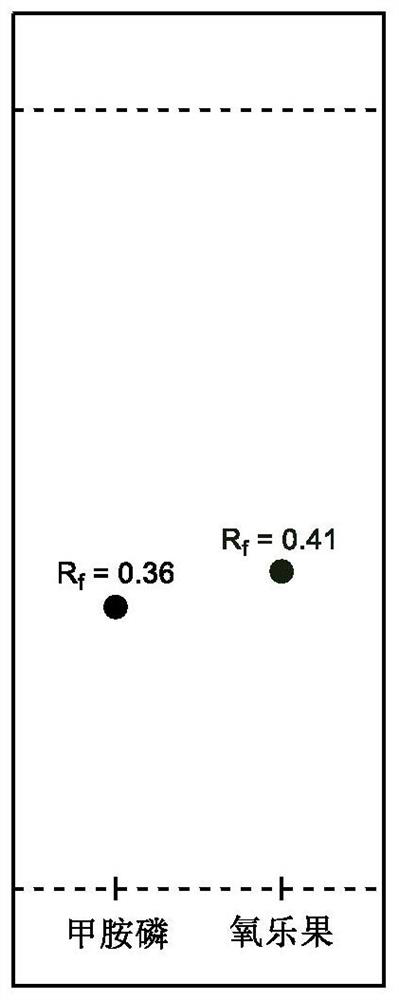Method for rapidly identifying recessively added prohibited and restricted pesticides in fertilizer
A fertilizer and rapid technology, applied in the rapid identification of the hidden addition of banned and restricted pesticides in fertilizers, rapid identification of the implicitly added two banned and restricted pesticides methamidophos and omethoate in fertilizers, in the field of thin layer chromatography, can solve the problem. Time-consuming and other problems, to achieve the effect of easy operation
- Summary
- Abstract
- Description
- Claims
- Application Information
AI Technical Summary
Problems solved by technology
Method used
Image
Examples
Embodiment 1
[0025] In the solid fertilizer in the present embodiment 1, the thin-layer chromatographic method for fast identification of two kinds of prohibited pesticides of recessively added methamidophos and omethoate comprises the following steps:
[0026] 1) Weigh 2g of solid fertilizer, add 5ml of ultrapure water, fully mix and dissolve, add 10ml of acetonitrile and 3g of sodium chloride, mix vigorously, and after standing for 30min, take 0.5ml of the supernatant;
[0027] 2) Spot 0.5ml sample on GF254 silica gel thin-layer plate with capillary tube, and after the solvent volatilizes for 1min, use a mixed solvent made of petroleum ether, dichloromethane, and methanol with a volume ratio of 3:6:1 to develop, and completely expand Finally, the thin-layer plate was taken out, and after the solvent evaporated for 1 min, the color was developed using a palladium chloride solution. Palladium chloride solution preparation method: Weigh 0.06g of palladium chloride solid (purity above 99%), ...
Embodiment 2
[0030] In the liquid fertilizer in the present embodiment 2, the thin-layer chromatography method of two kinds of banned pesticides of recessively adding methamidophos and omethoate rapidly is identified, comprises the following steps:
[0031] 1) Measure 5ml of liquid fertilizer, add 3ml of ultrapure water, mix and dissolve thoroughly, add 10ml of acetonitrile and 3g of sodium chloride, mix vigorously, and after standing for 30min, take 0.5ml of supernatant;
[0032] 2) Spot 0.5ml sample on GF254 silica gel thin-layer plate with capillary tube, and after the solvent volatilizes for 1min, use a mixed solvent made of petroleum ether, dichloromethane, and methanol with a volume ratio of 3:6:1 to develop, and completely expand Finally, the thin-layer plate was taken out, and after the solvent evaporated for 1 min, the color was developed using a palladium chloride solution. Palladium chloride solution preparation method: Weigh 0.06g of palladium chloride solid (purity above 99%),...
PUM
 Login to View More
Login to View More Abstract
Description
Claims
Application Information
 Login to View More
Login to View More - R&D
- Intellectual Property
- Life Sciences
- Materials
- Tech Scout
- Unparalleled Data Quality
- Higher Quality Content
- 60% Fewer Hallucinations
Browse by: Latest US Patents, China's latest patents, Technical Efficacy Thesaurus, Application Domain, Technology Topic, Popular Technical Reports.
© 2025 PatSnap. All rights reserved.Legal|Privacy policy|Modern Slavery Act Transparency Statement|Sitemap|About US| Contact US: help@patsnap.com

